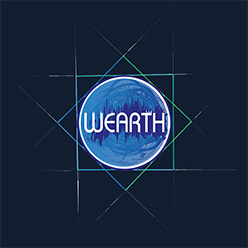Newsletter 2 - The Celtic bridge
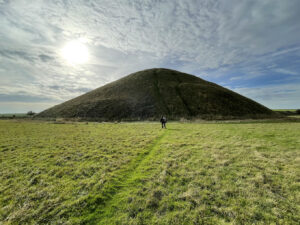
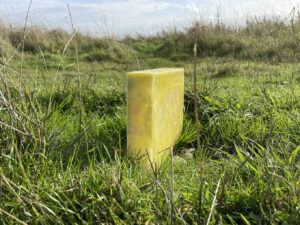
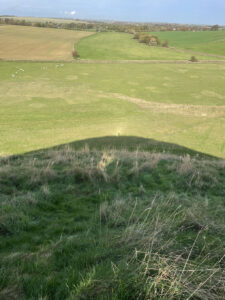
This is the second newsletter in our new format, dealing with placements in territories where Celtic culture is still vital. The placement 4A1B “TURNER” on Silbury Hill within the world heritage site of Avebury clearly shows that Land Art is not at all a US invention like a lot of media or so called artificial intelligence would tell you, but the plastic and sculptural work with the landscape is as old as our consciousness and makes us what we are. With this placement we made the statement that in fact Land Art is what the Sanskrit word “Trikala” would designate: knowledge of the past, the present and the future; thus timeless.
But the very first placement in the United Kingdom, 4A1A “TRUFLE”, was in Warminster / Brixton Deverill.
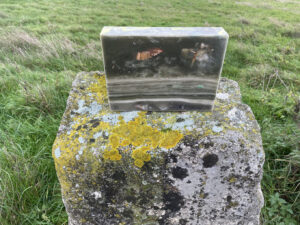
The placement was on top of a stone being part of a stone circle. This stone circle was not from the neolithic but created later from someone keeping up the tradition. Interestingly enough, none of the ubiquitous sheep ever entered the circle…. No rational reason to be found out. Later you will read more about “TRUFLE” in the section of the protocol placements on this website, but for now, this information should suffice, since this newsletter is about all “Celtic” placements so far.
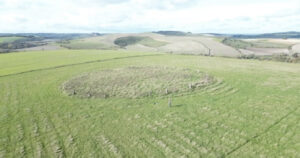
The last of the first three placements in the UK was close to a place you undoubtedly might have heard of, being perhaps the most iconic Land Art placement of all:
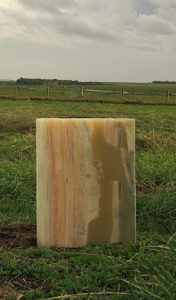
On this photo, in its left corner, you see Stonehenge. Nonetheless, beyond the reason of functional restrictions, 4A1C “TRAPPE” wasn’t placed directly at the world-famous site, but on a cult Land Art place nearby, which is lesser known and so much in the focus of world-wide attention.
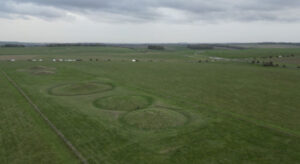
Our first placement in Brittany was “Temple”, 3B1A.
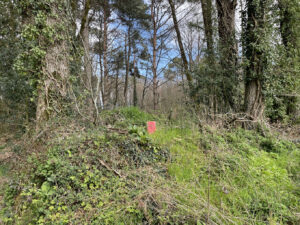
These series of WEARTH Land Art placements I made together with Taiwanese-German artist Ganga.
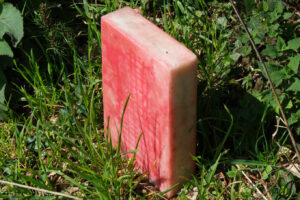
You see Ganga in the back on this shot of 3B1B “Vents” in Plumelec, Brittany.
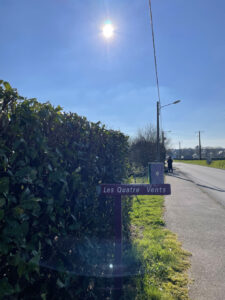
Just to remember the placement rules: whereas the placing artist may choose the first position in a triangle, the second and third one are at a 48-kilometre distance, measured on the road, not on a map. So, these placements discover or find something, a connection with the surrounding space. Only after the placement the bricks get their individual name. The reason for this brick named “Vents” is pretty obvious.
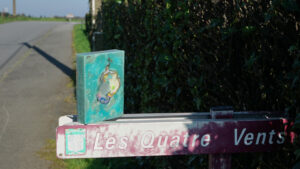
The last placement 3B1C in the first Brittany triangle is called “Sol”. In Spanish this means sun, in French it means soil.
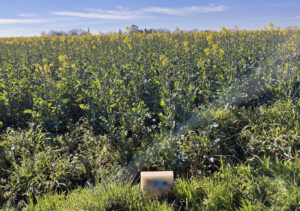
The plantations in this place do not distinguish between cereals or lower plants and trees: effectively and rationally, they are cultivated in rows so that plant nutrients and valuable substances are available for human use in a way that is as industrially machine-friendly as possible. This concept is thoroughly linked to the concept of the French garden: Strongly geometricised, human reason dominates wild nature. No wonder that the first “mown” lawn was in front of a castle on the Loire.
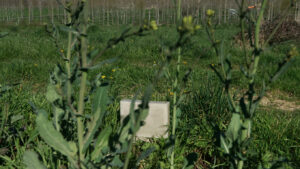
The first placement in the Hexagon C triangle in Brittany took place in Saint Mayeux. For this, our local Land Art placer, Anaïs, chose the menhir in the square of the small Celtic-Breton town that commemorated the Bridge of Freedom between 1789 and 1989.
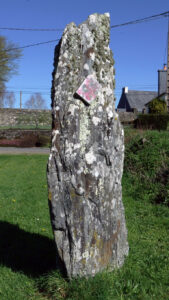
The menhir protruded about three metres above the surface of the earth. It was very convenient that Anaïs, a former professional basketball player, is rather tall. In a very natural way, she placed the stone on the rock at a height that would have been a hurdle for many. The purpose of this Celtic sculpture was quite clear: to establish a connection between heaven and earth, and of course to provide sufficient protection to prevent the sky from falling on one’s head.
Fittingly, she named the brick 3C1A “Pierre”; which means in French both Peter and stone.
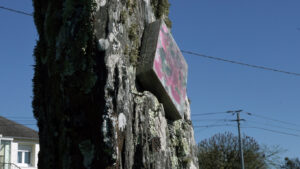
The second placement in this triangle, 3C1B was named “Diou”.
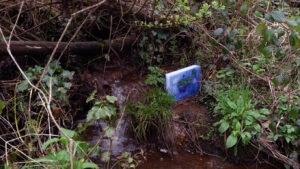
It was really in the nowhere of the Breton province, next to a babbling brook and on the remote hippie dwelling the dogs barked as soon as we went a little higher up the road.
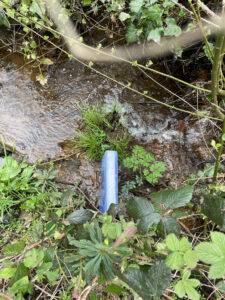
The third placement in this Breton triangle, 3C1C got the name “Pont”.
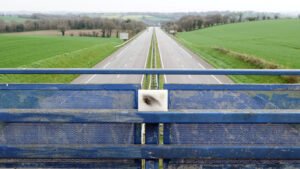
On a bridge of two traffic routes, the shape of traffic routes of our time and the landscape on and in which they act are shown. In the very translucent wax ingot “Pont” rests the wing of a dove and a ring showing the preferred round shape of Celtic Land Art sculptures.
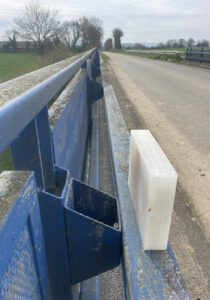
The second round of our Celtic placings started again in Brittany in our now 4th French triangle: 3D1A-C.
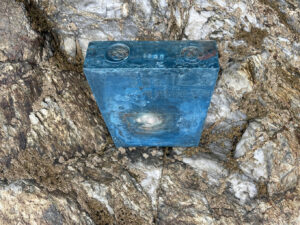
However, it was now calendrically summer, even if the temperatures were partly colder than in spring.
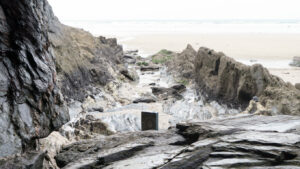
3D1A, “Madonne”, works on the one hand with a very special object that is inside the wax brick: in June, a worker who was busy with the renovations at Notre Dame Cathedral in Paris gave me an original stone from a pile of rubble of the unusable remains after the fire. Furthermore, blue is the classic colour of Mary in Christian iconography. Finding this grotto on the Atlantic Ocean near Plomodiern for placement finally brought the contents of the blue stone to full glow.
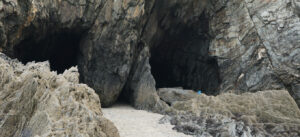
3D1B, “Dung”, was quite another, not so dramatic but probably more durable story. In the word dung we find the sense of animals’ faeces as well as fertiliser to agriculture.
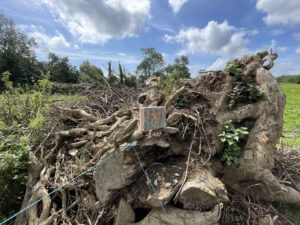
Here, near Plonéour-Lanvern, the fields were again like those known from other, mainly British Isles, Celtic regions: rather a small parcel of land lined with lush hedges and shrubbery. Not everything was centralised à-la-Parisienne on huge fields that were suitable for industrial machinery. So, it’s more a landscape for friends of a circular economy that is set up for the long term than the industrial form à la Bayer-Monsanto that idolises mere numerical growth.
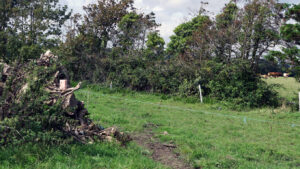
Those of you who already know this little video “barone-2” (https://vimeo.com/448908299?share=copy) may remember the making of this Wearth wax brick. Associations easily extend into the following subject areas: Intestines, warmth, cellular structures, symbiosis, other living things, other creatures, food, contrast between colours and shapes of rational (cuboids) as well as organic phenomena.
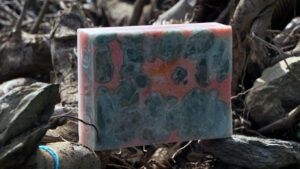
The Wearth wax bricks naturally have something of this circular logic: materials that have lost their original use are reused. This transformation creates something new, the constructive symbol of a brick, which in turn is subject to transformation at some point.
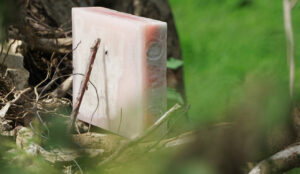
Even though we thought at the beginning that this 3D1C placement might be called “Grand” after the beach on which it is located, we finally decided on “Seal”. Seal has a double meaning in English, namely seal and seal. One of the three circles (on one of the two large sides of the square) that make up the Celtic-Breton seal is rather whitish and represents the face of a baby seal. The others are in black and red. White, black and red are the first three colours that the human brain learns while still in the womb.
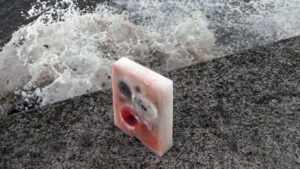
Despite the bad weather, with heavy rain and gusts of wind, there were quite a few tourists on the promenade. Most of them have their family-oriented holiday agenda, which is why they are not potential interview partners. Moreover, we are interested in the people who live in the respective place, and they are very rarely on this beach promenade.
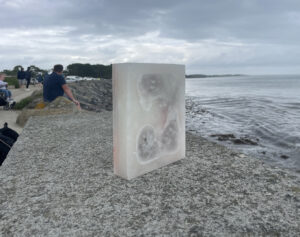
Our next of the Celtic placements, 4B1A, took place in Wales, in the Pembrokeshire Coastal National Park. It is always a bit difficult at the beginning and often almost arbitrary which triangle you choose first in a new country. At the beginning of our Welsh placements was the advice of a wonderful person, Claudia Andrews, who pointed us to this unique national park. Unique not only because of its incredible beauty, but also due to the fact that it is the only one on a coast. That the tip had high substance soon became apparent and was probably due to various circumstances: Claudia has roots in both Wales and Germany; a lot of love and spirit is there in both places.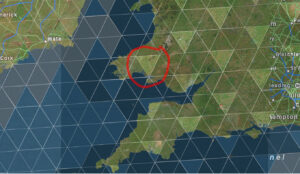
So the red circle indicates the location of our first Welsh triangle.
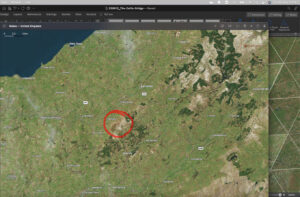
Our interest fell on a region which, when viewed from above on a map, did not appear to be characterised by fields and recognisable parcels of land. It appeared like an undefined large piece of land without uses, buildings or the like. Only a dead straight road (which also aroused my interest) and a few paths made the place accessible or developed.
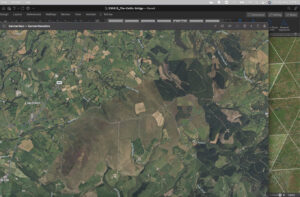
At the end of the dead straight stretch of road, one found oneself on the almost highest point of a hilly steppe landscape, which gave one a 360° view over the vast countryside. Furthermore, at this high point there was a round rampart from the Neolithic. Whether this was the site of a beacon, other ritual acts or even the site of an ancient tomb (or all of these together), could not be said with certainty. Nevertheless, it could be said with some certainty that it was the right place for “Gwerth”.
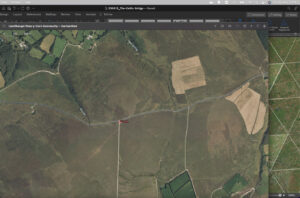
The Wearth wax brick that we then placed there had several peculiarities about it. Firstly, it was inspired by David Abram’s work and by a gift from him: a blue granite stone from Wales, those blue stones that are the stones of Stonehenge.
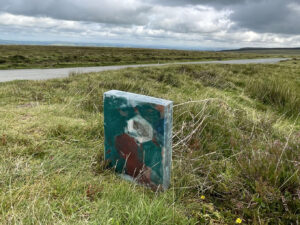
These two men are resident farmers: father and son-in-law. Both were important in their own way for this placement. The father enlightened me about the place: These steppe-like hills with their scattered sheep were common property and had been farmed in commons since time immemorial. Each of the farmers living there has the right to let 20-30 animals graze there. Just like me, they had a day of stonework that day: Loosely quarried from a local quarry, the older of the two brought in these stones with a trailer to plug the badly battered road with its potholes. He was not quite sure whether the son-in-law would manage to make it up here with the small roller or even get this machine to work. During this waiting time we talked. He learned about Wearth and helped me with the “correct” alignment of the wax brick. The blue stone inside the brick should point to those mountains where it was originally quarried.
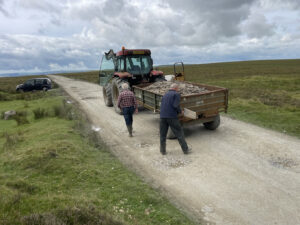
Despite his kind information and participation, the older man was camera shy and said his son-in-law was better suited anyway, as he preferred to speak Welsh. The unpaid work of the two in the service of the community, however, did not tolerate any delay. The dedication, skill and speed of their actions left no doubt that the statement that they unfortunately did not have time for a longer interview on camera was not a protective claim. Moreover, it seemed authentic and sincere when both of them said that they liked the project, but that it was a bit too complicated for the older one. And so, without perhaps being aware of it respectively and mutually, both made their three-dimensional, Celtic statement: the meaningful spatial action is preferable to any blah-blah.
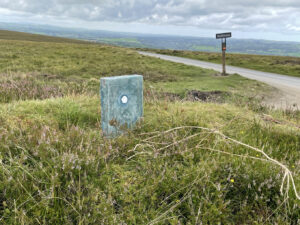
The other larger side seemed to anticipate the round old Land Art ground or plinth in its form: in accordance with the laws of metaphysical gravitation, the two spatial statements must have found each other…
At the end of the description of this placement, the name should be explained. At first we thought that the Celtic name “Werth” would be ideal: Everywhere you saw it there in front of houses for sale. And that is exactly what this name denotes, something that is for sale or a place of sale. As fitting as this may be in some respects, a placement in Germany was already named in exactly the same way after a nearby bus stop in a forest, by a stream that was dammed up to form a dam. It is not difficult to imagine that in our common Celtic past there was a Celtic sales point at this place now called German. But the Welsh is quite accurate and provided us with the name “Gwerth”, which in that language stands for “value”….
The second Welsh placement took us to a very different space: 4B1B, “Cymru” found its place by a stream over slate rock in a wood, not far from Cardigan.
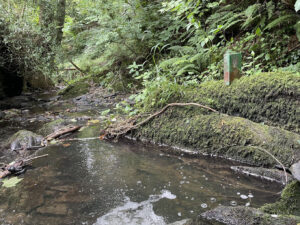
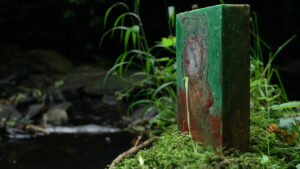
Cymru is the Welsh name for Wales.
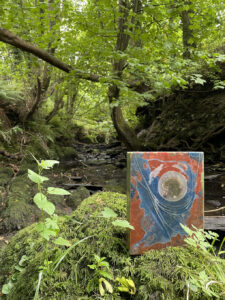
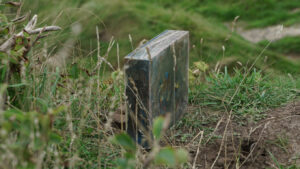
4B1C, “Sprinkle” has layers of different shades of grey that harmonises with different grey moods with the frequent drizzle here. The inlays in the Wearth wax brick are also small colourful dots. Just like the colourful clothes of the beach walking people look from the breezy (and windy) height of the cliff on which the placement took place.
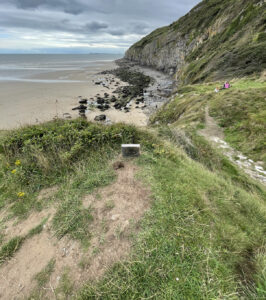
The other sides resonated with the colourfulness of yellow-ochre-green grass, opposing the indifference of the clouds in the stroke.
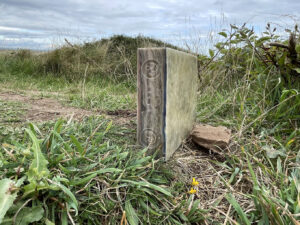
The next triangle was in Scotland, just Southwest from Edinburgh. 4C1A is called “Alba”, the Gaelic name for Scotland.
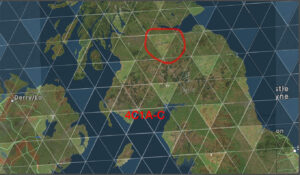
Talking confidentially with friends while writing enables you to listen to suggestions for improvement. My friend and Wearth co-creator Markus advised me to mention the time of placement for future reference. From now on, I want to do that for protocol placements. This placement here near Biggar in Scotland took place on 11 August 2023 at about 9:00am.
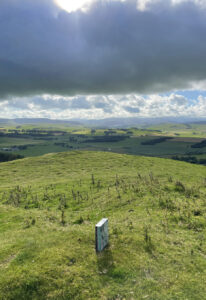
Just as some climb from the mountain to then grace their fellow human beings with supposedly divine word, so for this placement I climbed the mountain to place a designed body in this landscape, that it may sound poetic with it. Reverence and gratitude for the earth and its creator in its immensity are echoed in the colours and shapes of this Wearth wax brick “Alba”.
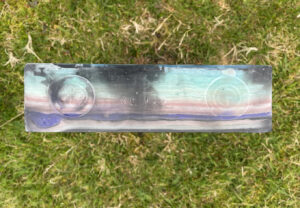
There were unbelievably strong winds, more like squalls, to cope with up there on the mountain hill, which was bare of sheep. Several times the wind blew in such a way that I had to change position. The architect’s enquiry in the Wearthies chat about the stability of the construction also had its justification, despite the material disfunctionality of a Wearth wax tile. Stone-dry sheep manure helped stabilise it, just enough to keep it from falling over all the time….
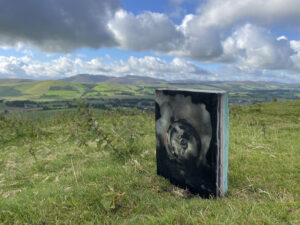
You can dimly make out the small town of Biggar in the background, down in the valley.
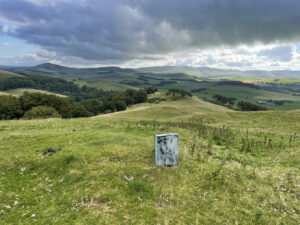
“He had to go very deep into the meadow, almost disappear,” Lucia explained later. Not only did she place stone 4C1B, “Panda”, at Shotts in a meadow in Scotland at 11:40 on 11 August 2023, she had made it beforehand. In this almost black and white stone, scratches are visible like fur, which seem to sound in chord with the blades of grass in the meadow.
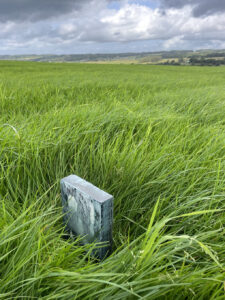 Following this video-link you may watch the location she chose a bit better.
Following this video-link you may watch the location she chose a bit better.
https://vimeo.com/858364527?share=copy
So it was no problem at all for her, when after a while of resisting the increasingly strong winds, the “Panda” gave way and tipped over into the soft meadow. “It’s really cool that it fell over. That’s nature!” said Lucia.
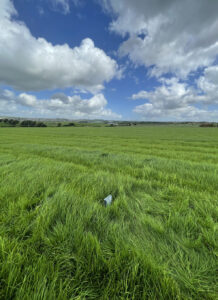
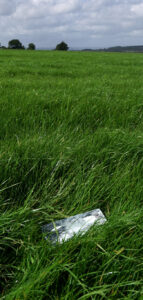
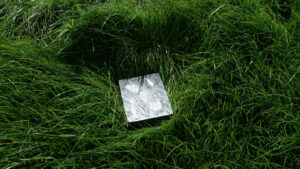
Soft is the transition between civilisation and wilderness in these suburban areas of Edinburgh. There, during our Land Art placement of 4C1C, “Sparta” we found golf courses, artificial ski ramps, sheep pastures, technical facilities and, last but not least, many detached houses with more or less large gardens (we do not want to conceal the one or other palazzo) and could hardly guess the actual city.
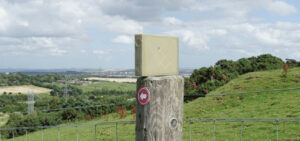
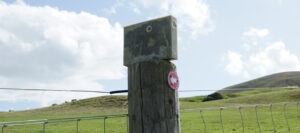

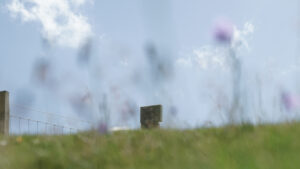
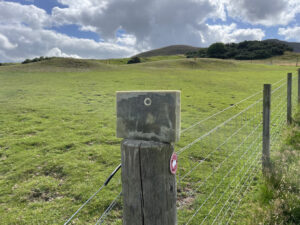
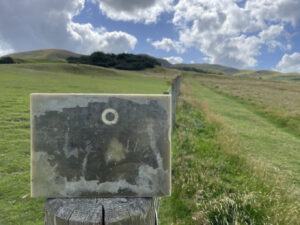
See you soon, and thank you, Scotland.
The start of triangle 4D1A-C in Dorset at the Jurassic Coast
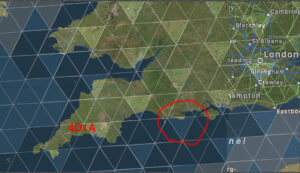
When we opened the aluminium case at Fru Tholstrup and her husband Soren’s, curiosity was high, because as long as the three stones are wrapped, you don’t know what is hidden behind the newsprint, after all they are all the same size. Soren finally discovered an unforeseeable circumstance, at 4D1A: the lower part of the enclosed child’s glove had exactly the shape of the coast in that stretch of land on the Jurassic Coast in Dorset where the first placement in this triangle was to take place. There was consensus among all present that Soren had to make this placement. As someone who lives there, he knew immediately where we had to go.
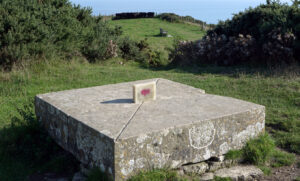
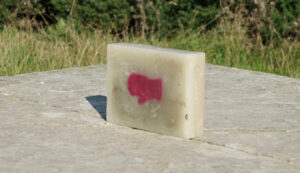
Around Encombe House, Wareham, Dorset, Soren placed and named “Sueño” the Wearth wax brick 4D1A overlooking the Jurassic Coast and the North Atlantic Ocean on Wednesday, August 16.
A herd of very black cows and a gigantic swarm of flying ants also enjoyed the place.
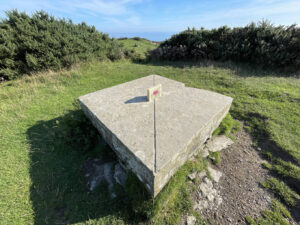
For the other two missing placements in this Jurassic Coast triangle, we will have to return. At least one of these will be Wearth ‘s first sea-placement.
Also, this report should not close without mentioning our magical encounter in Cardiff with Matt, who gave us Welsh honey. Especially he was so kind to indicate us to our next Welsh placements, up in the North, on an island, where druids still practice…
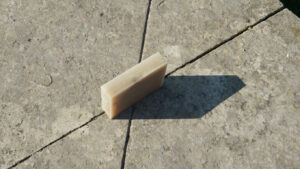
Please send me an email to jkk@wearth.eu if you want to subscribe or unsubscribe to our newsletter sendings.
And here is the link to the next newsletter: https://www.wearth.eu/newsletter1/newsletter-3/
